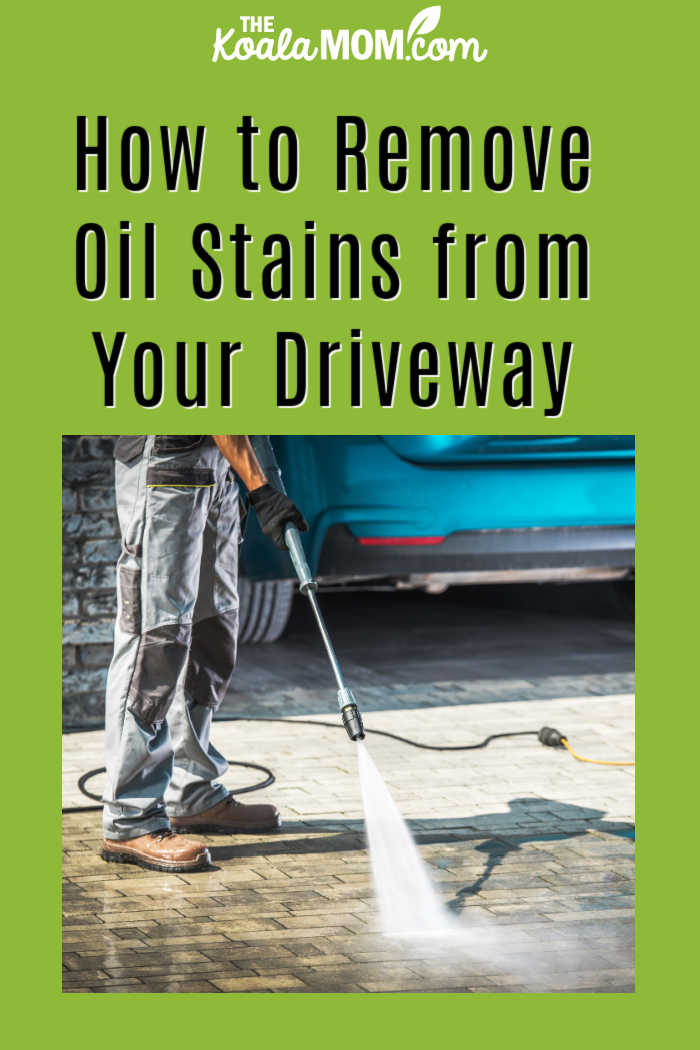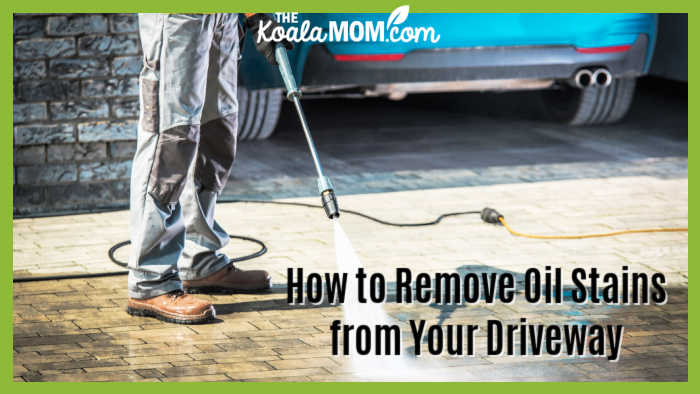Oil stains on your driveway can be unsightly and dangerous, making it essential to remove them as soon as possible. Over time, oil can penetrate deep into the driveway’s surface, making it difficult to remove. If left unattended, oil stains can cause significant damage to the surface of your driveway, reduce your home’s curb appeal and potentially lead to more severe problems, such as slipping hazards.
This article will provide a comprehensive guide for removing oil stains from your driveway, including tips and tricks for success from driveway cleaning specialists Renwash. Whether a homeowner or a property manager, it is essential to know how to properly remove oil stains from your driveway to keep it looking its best and avoid any potential dangers.

This post contains affiliate links for your shopping convenience; as an Amazon associate, I earn from qualifying purchases.
I’ve driven older vehicles for most of my life. Unfortunately, older vehicles are often prone to leaking various fluids. It can be embarrassing to have your friends over when there’s a pool of mysterious liquid in the driveway. And if your kids want to ride their bikes or scooters in the driveway, you may be concerned about safety. Keeping the driveway clean is important, so while you’re getting that leak on your vehicle checked, here are some tips for getting the driveway clean again too.
What is an Oil Stain?
An oil stain is a type of stain caused by the oil and grease from vehicle fluids, food, cosmetics, or other materials leaking onto another surface, such as a driveway, flooring, clothing, etc. As the oil and grease dry, they form a thick, sticky substance that can easily be wiped away with a cloth or a sponge but often leave behind an unsightly and persistent stain.
How to Remove Oil Stains from Your Driveway
1. Understand the Nature of Oil Stains
Oil stains on your driveway can be caused by various factors, including spilled gasoline, motor oil, and cooking oils. These liquids contain complex compounds that can penetrate deep into the driveway’s surface, making them difficult to remove.
The formation of oil stains on your driveway is a process that involves several different materials. The first and most important factor is the type of oil that is spilled. Different oils have different chemical compositions; some are more difficult to remove than others. For example, motor oil contains various compounds designed to resist high temperatures and wear, making it difficult to remove from a driveway surface.
The type of driveway surface also plays a key role in forming oil stains. Concrete driveways are porous, allowing liquids to penetrate the surface and form deep stains. Asphalt driveways are less porous but can still be susceptible to oil stains if not properly sealed. The age of the driveway and its previous exposure to oil also play a role in the formation and removal of oil stains.
2. Prepare to Remove the Stains
Before removing oil stains from your driveway, gathering the necessary materials and taking the appropriate safety precautions is essential. Depending on your chosen method, you may need household items such as baking soda, dish soap, and vinegar or commercial products such as degreasers and oil stain removers.
When removing oil stains, it is essential to take proper safety precautions. This may include wearing rubber gloves, safety glasses, and protective clothing to protect your skin and eyes from harmful chemicals. If you are using a commercial product, read and follow the manufacturer’s instructions carefully, paying close attention to any warnings and safety precautions.
The best time to remove oil stains from your driveway is as soon as you notice them. The longer the oil sits on the driveway’s surface, the more difficult it will be to remove. Try to remove the stain as soon as the oil is spilled. If the stain has had time to set in, don’t worry, there are still steps you can take to remove it.
3. Methods for Removing Oil Stains
There are several methods for removing oil stains from your driveway, including household items, commercial products, and a pressure washer system like TORC. Each method has its advantages and disadvantages. The method you choose will depend on the size and severity of the stain, the type of driveway surface, and the available materials.
Using Household Items:
- Baking soda and dish soap: Mix baking soda and dish soap into a paste and spread it over the stain. Let it sit for several hours, then scrub the area with a stiff brush and rinse with water.
- Vinegar: Sprinkle vinegar over the stain and sit for several hours. Scrub the area with a stiff brush and rinse with water.
Using Commercial Products:
- Degreasers: Apply a degreaser to the stain according to the manufacturer’s instructions. Let it sit for several minutes, then scrub the area with a stiff brush and rinse with water.
- Oil stain removers: Apply an oil stain remover to the stain according to the manufacturer’s instructions. Let it sit for the recommended time, then rinse it with water.
Using a Pressure Washer:
- Rent or purchase a pressure washer and adjust the pressure setting to the appropriate level for your driveway surface.
- Aim the nozzle at the stain and spray the area, careful not to damage the driveway’s surface.
- Repeat the process as necessary, then rinse the area with water.
You may need to repeat the cleaning process multiple times for stubborn stains or use a combination of methods for the best results. If the stain persists despite your efforts, consider seeking professional commercial pressure washing in Arizona to ensure a thorough and effective cleaning. Not only will they have the proper equipment and expertise to remove even the toughest stains, but they can also help protect your driveway from future damage.
No matter your chosen method, it is essential to be patient and persistent in removing oil stains from your driveway. It may take several attempts and a combination of methods to remove the stain completely, but with persistence, you can restore the appearance of your driveway.
Tips and Tricks for Successful Oil Stain Removal
In choosing the right method for removing oil stains from your driveway, several tips and tricks can help ensure success. Here are some key factors to keep in mind when removing oil stains:
- Treat the stains as soon as possible: The longer oil stains sit on your driveway, the more difficult they will be to remove. If you can treat the stains as soon as they occur, you will have a better chance of completely removing them.
- Avoid scrubbing too hard: When scrubbing the stains, it is essential to avoid scrubbing too hard, as this can damage the driveway’s surface. Instead, use a stiff brush and gentle, circular motions to work the cleaning solution into the stain.
- Let the cleaning solution sit: In many cases, letting the cleaning solution sit for a certain period can help to loosen and remove the oil stains. This is especially true for commercial products, which often require a certain amount of time to work.
Following these tips and tricks can increase your chances of successfully removing oil stains from your driveway. Removing oil stains can be time-consuming, but with patience and persistence, you can restore the appearance of your driveway and keep it looking clean and fresh.

Removing oil stains from your driveway is a crucial step in maintaining the appearance and value of your property. With the right techniques, materials, and patience, you can effectively remove oil stains and keep your driveway looking clean and fresh.
Photo credit: Depositphotos.

No Responses Yet